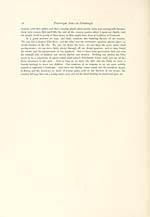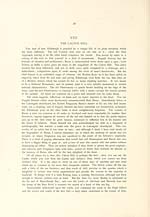Non-Fiction > Books > London, 1879 - Edinburgh
(47) Page 27 - Villa quarters
Download files
Complete book:
Individual page:
Thumbnail gallery: Grid view | List view

27
VII.
THE VILLA QUARTERS.
Mr. RUSKIN'S denunciation of the New Town of Edinburgh includes, as I have heard
it repeated, nearly all the stone and lime we have to show. Many however find a grand air
and something settled and imposing in the better parts ; and upon many, as I have said, the
confusion of styles induces an agreeable stimulation of the mind. But upon the subject of our
recent villa architecture, I am frankly ready to mingle my tears with Mr. Ruskin's, and it is
a subject which makes one envious of his large declamatory and controversial eloquence.
Day by day, one new villa, one new object of offence, is added to another ; all around
Newington and Morningside, the dismallest structures keep springing up like mushrooms ;
the pleasant hills are loaded with them, each impudently squatted in its garden, each roofed
and carrying chimneys like a house. And yet a glance of an eye discovers their true
character. They are not houses ; for they were not designed with a view to human habitation,
and the internal arrangements are, as they tell me, fantastically unsuited to the needs of
man. They are not buildings; for you can scarcely say a thing is built where every measure-
ment is in clamant disproportion with its neighbour. They belong to no style of art, only
to a form of business much to be regretted.
Why should it be cheaper to erect a structure where the size of the windows bears no
rational relation to the size of the front ? Is there any profit in a misplaced chimney-stalk ?
Does a hard-working, greedy builder gain more on a monstrosity than on a decent cottage
of equal plainness ? Frankly, we should say, No. Bricks may be omitted, and green timber
employed, in the construction of even a very elegant design ; and there is no reason why a
chimney should be made to vent, because it is so situated as to look comely from without.
On the other hand, there is a noble way of being ugly : a high-aspiring fiasco like the fall of
Lucifer. There are daring and gaudy buildings that manage to be offensive, without being
contemptible ; and we know that ' fools rush in where angels fear to tread.' But to aim at
making a common-place villa, and to make it insufferably ugly in each particular ; to attempt
the homeliest achievement and to attain the bottom of derided failure ; not to have any theory
but profit and yet, at an equal expense, to outstrip all competitors in the art of conceiving and
rendering permanent deformity ; and to do all this in what is, by nature, one of the most
agreeable neighbourhoods in Britain : — what are we to say, but that this also is a distinction,
hard to earn although not greatly worshipful ?
Indifferent buildings give pain to the sensitive ; but these things offend the plainest
taste. It is a danger which threatens the amenity of the town ; and as this eruption keeps
spreading on our borders, we have ever the farther to walk among unpleasant sights, before
we gain the country air. If the population of Edinburgh were a living, autonomous body,
it would arise like one man and make night hideous with arson ; the builders and their
accomplices would be driven to work, like the Jews of yore, with the trowel in one hand
and the defensive cutlass in the other ; and as soon as one of these masonic wonders had
been consummated, right-minded iconoclasts should fall thereon and make an end of it at once.
Possibly these words may meet the eye of a builder or two. It is no use asking them
to employ an architect ; for that would be to touch them in a delicate quarter, and its use
would largely depend on what architect they were minded to call in. But let them get any
architect in the world to point out any reasonably well-proportioned villa, not his own
design ; and let them reproduce that model to satiety.
VII.
THE VILLA QUARTERS.
Mr. RUSKIN'S denunciation of the New Town of Edinburgh includes, as I have heard
it repeated, nearly all the stone and lime we have to show. Many however find a grand air
and something settled and imposing in the better parts ; and upon many, as I have said, the
confusion of styles induces an agreeable stimulation of the mind. But upon the subject of our
recent villa architecture, I am frankly ready to mingle my tears with Mr. Ruskin's, and it is
a subject which makes one envious of his large declamatory and controversial eloquence.
Day by day, one new villa, one new object of offence, is added to another ; all around
Newington and Morningside, the dismallest structures keep springing up like mushrooms ;
the pleasant hills are loaded with them, each impudently squatted in its garden, each roofed
and carrying chimneys like a house. And yet a glance of an eye discovers their true
character. They are not houses ; for they were not designed with a view to human habitation,
and the internal arrangements are, as they tell me, fantastically unsuited to the needs of
man. They are not buildings; for you can scarcely say a thing is built where every measure-
ment is in clamant disproportion with its neighbour. They belong to no style of art, only
to a form of business much to be regretted.
Why should it be cheaper to erect a structure where the size of the windows bears no
rational relation to the size of the front ? Is there any profit in a misplaced chimney-stalk ?
Does a hard-working, greedy builder gain more on a monstrosity than on a decent cottage
of equal plainness ? Frankly, we should say, No. Bricks may be omitted, and green timber
employed, in the construction of even a very elegant design ; and there is no reason why a
chimney should be made to vent, because it is so situated as to look comely from without.
On the other hand, there is a noble way of being ugly : a high-aspiring fiasco like the fall of
Lucifer. There are daring and gaudy buildings that manage to be offensive, without being
contemptible ; and we know that ' fools rush in where angels fear to tread.' But to aim at
making a common-place villa, and to make it insufferably ugly in each particular ; to attempt
the homeliest achievement and to attain the bottom of derided failure ; not to have any theory
but profit and yet, at an equal expense, to outstrip all competitors in the art of conceiving and
rendering permanent deformity ; and to do all this in what is, by nature, one of the most
agreeable neighbourhoods in Britain : — what are we to say, but that this also is a distinction,
hard to earn although not greatly worshipful ?
Indifferent buildings give pain to the sensitive ; but these things offend the plainest
taste. It is a danger which threatens the amenity of the town ; and as this eruption keeps
spreading on our borders, we have ever the farther to walk among unpleasant sights, before
we gain the country air. If the population of Edinburgh were a living, autonomous body,
it would arise like one man and make night hideous with arson ; the builders and their
accomplices would be driven to work, like the Jews of yore, with the trowel in one hand
and the defensive cutlass in the other ; and as soon as one of these masonic wonders had
been consummated, right-minded iconoclasts should fall thereon and make an end of it at once.
Possibly these words may meet the eye of a builder or two. It is no use asking them
to employ an architect ; for that would be to touch them in a delicate quarter, and its use
would largely depend on what architect they were minded to call in. But let them get any
architect in the world to point out any reasonably well-proportioned villa, not his own
design ; and let them reproduce that model to satiety.
Set display mode to: Large image | Transcription
Images and transcriptions on this page, including medium image downloads, may be used under the Creative Commons Attribution 4.0 International Licence unless otherwise stated. ![]()
| Early editions of Robert Louis Stevenson > Non-Fiction > Books > Edinburgh > (47) Page 27 - Villa quarters |
|---|
| Permanent URL | https://digital.nls.uk/99396699 |
|---|
| Form / genre: |
Written and printed matter > Books |
|---|---|
| Dates / events: |
1879 [Date published] |
| Places: |
Europe >
United Kingdom >
Scotland >
Edinburgh >
Edinburgh
(inhabited place) [Place depicted] Europe > United Kingdom > England > Greater London > London (inhabited place) [Place published] |
| Subject / content: |
Capital cities Description |
| Person / organisation: |
Bough, Samuel, 1822-1878 [Artist] Seeley Jackson & Halliday [Publisher] Stevenson, Robert Louis, 1850-1894 [Author] Brunet-Debaines, A. (Alfred), 1845- [Etcher] Lockhart, William Ewart, 1846-1900 [Artist] Chalmers, Hector, 1849-1943 [Illustrator] Thomas, R. Kent (Robert Kent), 1816-1884 [Illustrator] |
| Person / organisation: |
Stevenson, Robert Louis, 1850-1894 [Author] |
|---|



